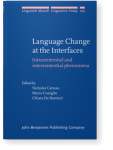Julia Bacskai-Atkari
List of John Benjamins publications for which Julia Bacskai-Atkari plays a role.
2022 Discourse-driven asymmetries between embedded interrogatives and relative clauses in West Germanic Language Change at the Interfaces: Intrasentential and intersentential phenomena, Catasso, Nicholas, Marco Coniglio and Chiara De Bastiani (eds.), pp. 189–214 | Chapter
The article examines embedded constituent questions and relative clauses in West Germanic, arguing that asymmetries regarding doubly filled COMP patterns are due to information-structural differences. While both clause types involve operator movement, they differ crucially regarding the… read more
2020 Changes affecting relative clauses in Late Modern English Late Modern English: Novel encounters, Kytö, Merja and Erik Smitterberg (eds.), pp. 91–116 | Chapter
This paper presents the results of a corpus study comparing relative markers (relative complementisers and relative pronouns) in the King James Bible and its modernised version, focusing on subject and object relative clauses involving a human referent. The attested differences indicate changes… read more
2020 Non-degree equatives and reanalysis: A case study of doubling patterns in German and Hungarian Approaches to Hungarian: Volume 16: Papers from the 2017 Budapest Conference, Hegedűs, Veronika and Irene Vogel (eds.), pp. 5–24 | Chapter
The article examines reanalysis processes underlying doubling patterns in non-degree equatives in German and Hungarian. In German, the combination als wie (lit. ‘as how’) is attested historically and in certain present-day dialects. Traditionally, it is assumed to be a mixed pattern involving the… read more
2018 Complementizers and negative polarity in German hypothetical comparatives The Grammatical Realization of Polarity Contrast: Theoretical, empirical, and typological approaches, Dimroth, Christine and Stefan Sudhoff (eds.), pp. 89–108 | Chapter
The article examines the synchronic and diachronic relation between German hypothetical comparatives and ordinary comparatives. While the presence of an overt equative complementizer is not universally obligatory, it is so in hypothetical comparatives, whereas a conditional complementizer may be… read more
2017 Chapter 2. Structural ambiguity and case assignment in Hungarian clausal and phrasal comparatives Approaches to Hungarian: Volume 15: Papers from the 2015 Leiden Conference, Hulst, Harry van der and Anikó Lipták (eds.), pp. 35–63 | Chapter
This paper presents a contrastive analysis of comparative degree complements in Germanic (English, German) and Hungarian, focussing on two particular types of constructions that are potentially ambiguous in isolation. I argue that Hungarian has both clausal and phrasal comparatives. In clausal… read more
2014 Cyclical change in Hungarian comparatives Diachronica 31:4, pp. 465–505 | Article
This paper examines cyclical changes in comparative subclauses, showing how operators are reanalysed as complementisers via the general mechanism of the relative cycle, and how this is related to whether certain lexical elements have to be deleted at the left periphery. I also show that only… read more
2013 Reanalysis in Hungarian comparative subclauses Approaches to Hungarian: Volume 13: Papers from the 2011 Lund conference, Brandtler, Johan, Valéria Molnár and Christer Platzack (eds.), pp. 5–32 | Article
My paper presents a diachronic study of the Left Periphery of Hungarian comparative subclauses, primarily focussing on the development of the complementisers and the operator. Adopting a cartographic approach, I will show that there were two main interrelated processes at work in the development of… read more






